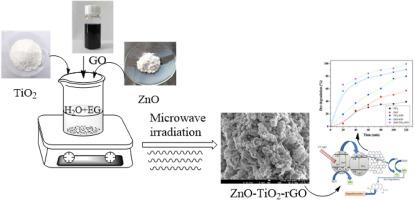Eco-friendly fabrication of ZnO-TiO2-rGO nanocomposite for efficient adsorption-assisted organic dyes elimination
IF 2.9
Q1 MATERIALS SCIENCE, CERAMICS
引用次数: 0
Abstract
The growing interest in combining the photocatalytic properties of semiconductors like ZnO and TiO2 with the superior electron conduction capabilities of graphene has resulted in the successful synthesis of in-situ reduced graphene oxide (rGO) supported ZnO-TiO2 nanostructures through a simple microwave-assisted synthesis method. X-ray Diffraction Spectroscopy (XRD), Field Emission Scanning Electron Microscope (FESEM), UV–visible spectroscopy (UV–vis), and Fourier Transform Infrared Spectroscopy (FTIR) were employed to characterize structural, morphological and optical properties as well as surface functional groups of the synthesized products. The XRD measurements of our synthesized samples confirm both structural crystallinity and phase purity, while the FTIR analysis verifies the complete reduction of graphene oxide (GO) to reduced graphene oxide (rGO). The synthesized ternary nanocomposite ZnO-TiO2-rGO exhibited a remarkable 100 % adsorption-assisted removal efficiency for 20 mg/L methylene blue (MB) dye under ultraviolet light illumination within 120 min, along with a 56 % dye adsorption removal efficiency in the same time interval. In comparison, pure ZnO showed 0 % adsorption and only 31 % photocatalytic efficiency at the similar condition. Remarkably, the ZnO-TiO2-rGO nanocomposite exhibited exceptional photocatalytic activity mediated by adsorption, achieving complete degradation of MB dye within 5 min under sunlight irradiation. The photocatalytic efficiency and dye adsorption capacity were found to be significantly lower for the anionic dye methyl orange (MO) compared to the cationic MB dye. The study thoroughly investigated the influence of catalyst dose and initial dye concentration on photodegradation. The proposed mechanism indicates that the extensive surface area and numerous active sites on the rGO promote adsorption, which is then followed by degradation through the metal oxides. Overall, the results unveil that the microwave-assisted synthesis of ZnO-TiO2-rGO nanocomposite is a promising and environmentally friendly approach for efficiently degrading dyes from contaminated wastewater using both UV light and natural sunlight irradiation.

以环保方式制备 ZnO-TiO2-rGO 纳米复合材料,用于高效吸附辅助去除有机染料
人们对将氧化锌和二氧化钛等半导体的光催化特性与石墨烯的卓越电子传导能力相结合的兴趣与日俱增,因此通过一种简单的微波辅助合成方法,成功合成了原位还原氧化石墨烯(rGO)支撑的氧化锌-二氧化钛纳米结构。我们采用了 X 射线衍射光谱(XRD)、场发射扫描电子显微镜(FESEM)、紫外可见光谱(UV-vis)和傅立叶变换红外光谱(FTIR)来表征合成产物的结构、形态和光学性质以及表面官能团。对合成样品的 XRD 测量证实了其结构结晶性和相纯度,而傅立叶变换红外光谱分析则验证了氧化石墨烯(GO)完全还原为还原型氧化石墨烯(rGO)。合成的三元纳米复合材料 ZnO-TiO2-rGO 在紫外光照射下,120 分钟内对 20 mg/L 亚甲基蓝(MB)染料的吸附去除率达到 100%,在相同时间间隔内对染料的吸附去除率达到 56%。相比之下,纯氧化锌在类似条件下的吸附率为 0%,光催化效率仅为 31%。值得注意的是,ZnO-TiO2-rGO 纳米复合材料在吸附作用的介导下表现出优异的光催化活性,在阳光照射下 5 分钟内就能完全降解 MB 染料。研究发现,与阳离子甲基橙(MO)相比,阴离子甲基橙(MO)的光催化效率和染料吸附能力明显较低。研究深入探讨了催化剂剂量和初始染料浓度对光降解的影响。提出的机理表明,rGO 上广泛的表面积和众多的活性位点促进了吸附,然后通过金属氧化物进行降解。总之,研究结果表明,微波辅助合成 ZnO-TiO2-rGO 纳米复合材料是一种利用紫外线和自然光照射高效降解受污染废水中染料的有前途的环保方法。
本文章由计算机程序翻译,如有差异,请以英文原文为准。
求助全文
约1分钟内获得全文
求助全文
来源期刊

Open Ceramics
Materials Science-Materials Chemistry
CiteScore
4.20
自引率
0.00%
发文量
102
审稿时长
67 days
 求助内容:
求助内容: 应助结果提醒方式:
应助结果提醒方式:


